At one point in time the temperate oceans of the Caribbean were filled with billions of sea turtles. During Christopher Columbus 4th voyage in 1503, he came across two small islands and the surrounding ocean was full of sea turtles that looked like little rocks.
He thought he could walk across the water on the backs of the sea turtles. Columbus named the islands Tortugas or “Turtle Islands.” They became the Cayman Islands, home to one of the world’s largest green turtle population.
After European settlement in the Caribbean, the turtle population depleted, due to intense trade for their meat and for their decorative shells. The British colonists’ desire for turtle meat was so great that the Cayman Islands became a killing field for nesting females.
The long history of dependence on turtles remains part of the Cayman culture; turtle stew remains an important native dish. To sustain the need for turtle meat in the Cayman Islands and beyond, a breeding farm opened its doors. The Cayman Turtle Farm operated for over 20 years with the controversial mission of breeding turtles for human consumption.
Fortunately the Conversation International Trade for Endangered Species (CITES) ended the trade of sea turtles and associated products from the island. However, Caymanians still demanded turtle meat, so the farm turned to tourism to keep its doors open. Every year over a half a million tourists observe, swim, and interact with these sea turtles, without realizing that many of these sea turtles will be killed and eaten by humans. Misinformed tourists think the farm supports sea turtle conservation by breeding and releasing captive turtles into the wild.
“The Cayman Farm has a long history of working to ease international regulations that would allow them to market and sell turtle meat and shell produced at the Farm,” says David Godfrey, Executive Director of the Sea Turtle Conservancy (STC). “Green turtles have been given a chance at recovery precisely because the Sea Turtle Conservancy has eliminated the international demand for their products.”
 The World Society for the Protection of Animals (WPCA) recently received complaints from Cayman Farm tourists regarding filthy, overcrowded conditions, and sick and injured sea turtles. A year-long investigation detailed these conditions:
The World Society for the Protection of Animals (WPCA) recently received complaints from Cayman Farm tourists regarding filthy, overcrowded conditions, and sick and injured sea turtles. A year-long investigation detailed these conditions:
-Cannibalism
-Disease
-Dirty water
-Poor diet
-Improper handling
-Birth Defects
-Neglect and overcrowding
WPCA declared the Cayman Farms detrimental to human and to animal welfare. WPCA and STC state captive turtle release into the wild can introduce new diseases into the wild Caribbean population. The wild turtle offspring and Cayman Farm turtles may lack the ability to navigate to critical foraging, breeding, and nesting sites.
WPCA strongly urges the Cayman Turtle farm to end commercial sea turtle production by replacing it with a research and education facility for injured and ill sea turtles.
The Cayman Farm rejected their plan.
“”Unless someone like you cares a whole awful lot, nothing is going to get better,” says The Lorax. “It’s not.”
You can take action at www.stopseaturtlefarm.org
Guest post by: Natalie Hummel
Post first appeared in Earth Times
Sea Turtle Conservancy (STC) has received three grants awarded by Florida’s Sea Turtle Grants Program to support sea turtle-friendly lighting education and loggerhead migratory research.
Two of the grants focus on educating coastal residents in Florida about the impacts of beachfront lights to nesting females and sea turtle hatchlings and offering options for converting existing lights to amber LED fixtures that minimize impacts to sea turtles.
“It is important for people to see turtle-friendly lighting first-hand,” STC’s lighting specialist Karen Shudes said. “There are several myths about sea turtle-friendly lighting not being safe enough or bright enough, but these are simply not true.”
Artificial lights are a major threat to nesting sea turtles and hatchlings because 78% of Florida’s housing is located in coastal communities. These grants will help STC educate the public on the importance of making sure beachfront homes have the right type of lights to ensure safety for people and sea turtles.
The third grant is studying the migratory routes and foraging grounds used by loggerhead turtles from the Archie Carr Refuge in Melbourne Beach. The goal is to reveal important information about the turtles’ migratory behavior, foraging grounds, and the areas of potential conflict with commercial fisheries or legal harvest of sea turtles.
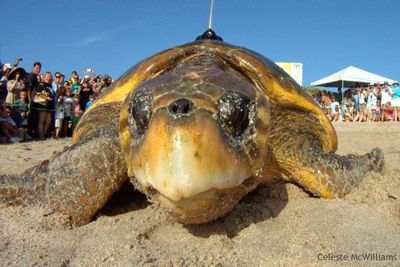
Currently, there are four turtles being tracked in this research study. Two turtles went to areas that STC had not observed before in the waters off Florida’s Panhandle and to the Yucatan Peninsula.
These grants are supporting critical programs that are increasing knowledge about sea turtles and providing solutions to ensure their survival. The grants were made possible by the sale of the “Helping Sea Turtles Survive” specialty license plate, which funds Florida’s Marine Turtle Protection Program and the Sea Turtle Grants Program. To learn more, visit www.helpingseaturtles.org.
Is there anything sweeter than a charm that gives back? Altruette is rolling out its line of charms for girls at Nordstorm, and Sea Turtle Conservancy is excited to have a turtle charm part of the collection. The charm is adorable and each one comes attached to a card with information about Sea Turtle Conservancy. 
This holiday season give a gift that helps sea turtles. The charms will be available in Nordstorm stores around the country and also online at altruette.com or nordstrom.com. These charms are a great way to inspire young girls to be to give back. The designs are colorful, stylish and fun with inspiring messages that appeal to girls and their moms, aunts, grandmothers.
“We are thrilled to be supporting the amazing work of Sea Turtle Conservancy,” said Julie Schlosser, Altruette Co-Founder. “Sea turtles are such a vital part of the marine ecosystem, and we feel good knowing that the STC is working to protect this critical population.”
Imagine how excited your girl will be when she learns that her new beautiful charm is helping to save sea turtles. Proceeds from the charms benefit sea turtle populations in the Caribbean, Atlantic and Pacific Oceans by supporting research, education, advocacy and the protection of their natural habitats. Sea Turtle Conservancy believes that sea turtles are among the most important indicators of the health of the world’s marine and coastal ecosystems. Join us in protecting sea turtles by giving this gift to a special girl or young woman in your life. For more information about the charms please visit www.altruette.com.
To: Sea Turtle Conservancy
From: Ashley
I am so proud of you guys, and I have always loved the sea. And when I grow up, I want to be a Marine Biologist with dolphins and turtles. Here is a little reminder of how proud I am of your guys.
Love,
Ashley 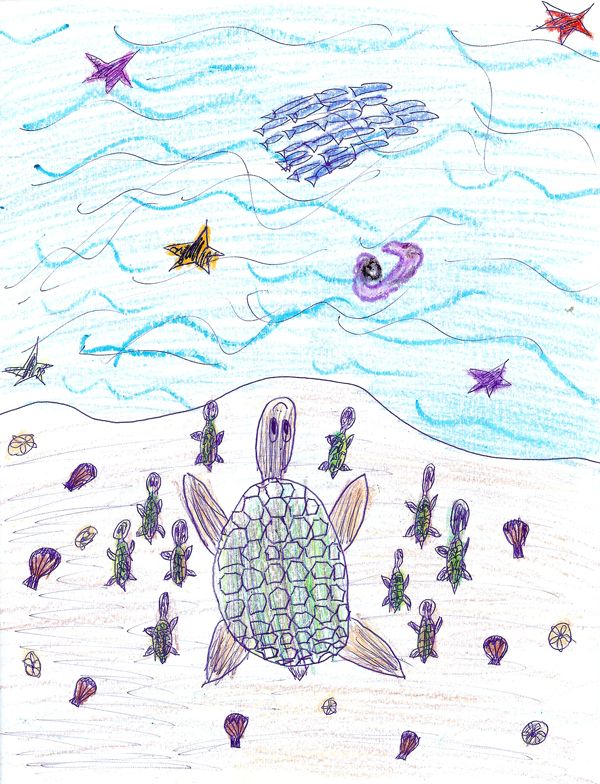
From the staff at STC, thank you for sharing your nice comments and sending us your beautiful drawing!
More so than many other tropical locations throughout the world, Costa Rica is an important location for sea turtle nesting. But the five species that call the country’s two coasts home are being severely threatened by a number of dangers, pushing these creatures towards the point of extinction. We should all be aware of these threats and what we can do to help out so that we may preserve these species for centuries to come.
Introducing Costa Rica’s Sea Turtles
Costa Rica is amongst the world’s premier destinations to view nesting sea turtles. The species that are found in Costa Rica include the Hawksbill, Green, Black (a Pacific subpecies of green turtles), Olive Ridley, Loggerhead and the massive Leatherback sea turtle. Sea turtles are important to the health of the world’s oceans, and unfortunately six of the seven turtle species in the world are on the threatened or endangered list.
National parks have been put in place to help protect the most important nesting areas. Tortuguero National Park for instance is a breeding ground of four species of sea turtle. Two other turtle-inspired spots are located in the Guanacaste province. Ostional National Wildlife Refuge is located near the town of Nosara and is one of the world’s key breeding grounds of the olive ridley sea turtle. Las Baulas (Leatherback) National Park is near the picturesque beach of Playa Grande, which is a large Leatherback beach.
Dangers
All of these species found in Costa Rica are either on the endangered or threatened list and all a number of dangers, including commercial fishing, egg poaching and both light and garbage pollution.
-Commercial fishing: Turtles are threatened by both long line and commercial fishing nets. Sea turtles like all reptiles breathe air. It is very common for a turtles to become entangled in nets or hooked in lines leading them to drown.
– Poaching: The fact is the local population enjoys the taste of sea turtle meat and uses turtle eggs as a supposed aphrodisiac. This leads to the hunting and harvesting of sea turtles and their eggs throughout. Restrictions have been put in place by the government and have helped reduced poaching, but these regulations are difficult to enforce.
– Light Pollution: Development of communities and commercial properties along nesting beaches has created light pollution that confuses and disorients the turtles and their hatchlings. Uneducated visitors are also a problem, as many go to the beaches looking for nesting turtles but are unaware that normal flashlights cause the same light problems as the developments. Red LED lights are the most eco-friendly way to view turtle nesting at night. The red light’s wavelength does not affect the turtles as much, allowing for successful nesting. It is always good policy to view nesting turtles with certified guides to ensure their safety.
– Garbage: There are many problems that result from humans polluting, but one of the direct threats to the leatherback species and other species is the presence of plastic bags. Plastic bags are easily mistaken for jelly fish, a staple in the leatherback diet. Plastic bag consumption leads to blockages the throat and digestive systems causing starvation and even death. Cigarette butts and oil droplets are also among the many hazardous items that do not belong in Earth’s oceans.
What you can do to help
Learning about sea turtles and not littering are some of the easiest thing you can do to help save not just Costa Rica’s sea turtles but the world’s oceans. If you have some free time and a big heart, you can also volunteer at one of many non-profits programs set in place to help sea turtle conservation. If we all help a little it will make a great difference.
Guest blog post written by Matt Ymbras for TV Pura Vida
To volunteer working with sea turtles in Costa Rica, visit www.conserveturtles.org to learn about our Eco-Volunteer Adventures.
The Sea Turtle’s Plea
I am a giant turtle
And with my shell I hurtle
Over rocks and sticks
To the blue, blue sea.
Though I may be slow on land–
My flippers struggle on sand–
My speed can’t be matched
In the deep, blue sea.
However . . .
I now swim zigs and zags
’round plastic bottles and bags.
What’s all this doing
In the once blue sea?
Please promise to stop this mess–
Just recycle and use less–
So I can swim fast
In a clear, blue sea.
By Carole Mackey,
Educator and Sea Turtle Fan
In an effort to get the word out about endangered species and help make a difference through education, College Degree Net published a list with their choices for the Top 100 Animal Preservation Blogs.
Here is what they had to say about Sea Turtle Conservancy’s blog:
“Fortunately, visibility for the need to protect sea turtles has boomed recently. This blog helps you direct your concern to practical and effective modes of support.”
Thanks for the kudos College Degree Net!
Got New Year’s resolutions on the mind? Get organized with the 2011 Sea Turtle Scenes Calendar featuring the winners from STC’s calendar contest. Click here to get your calendar today!
To see see the individual pictures and names of winning photographers, please visit our STC page on Facebook.

Every now and then, we get a letter that touches our hearts. This one came just in time for the holidays, and we wanted to share it with our sea turtle fans.
Sammy donated $83 for the holidays that he collected from working at his lemonade/hot chocolate stand. Along with his donation, he sent us a letter and a decorated envelope.
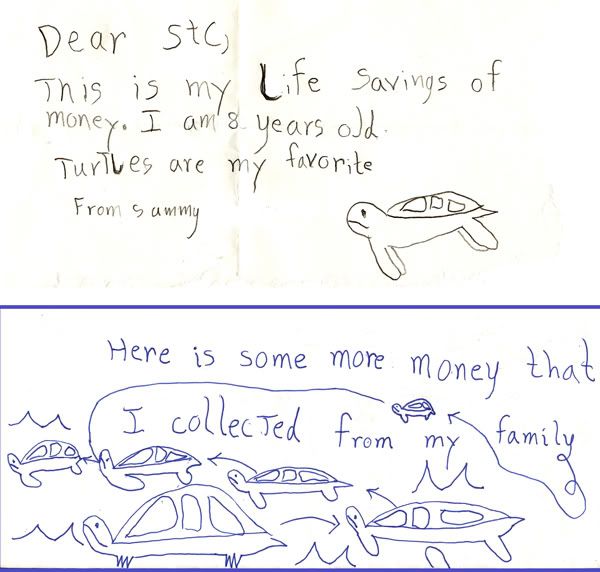
Sammy at his hot chocolate/coffee stand
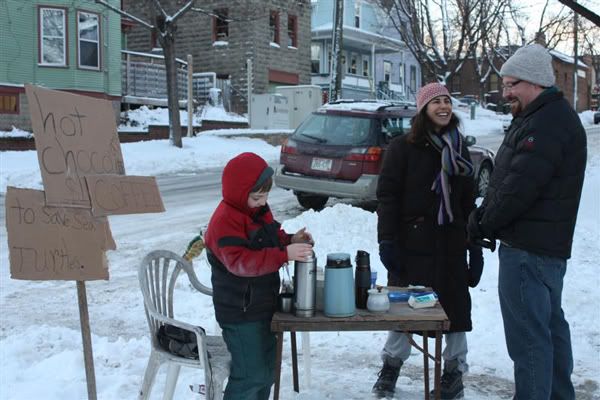
Thanks Sammy for spreading sea turtle love this holiday season!
From the staff at STC
After years of working in the magazine industry, Julie Schlosser and Lee Clifford decided to transform their passion for doing good into action.
They formed Altruette, a philanthropic line of charm bracelets.
“The Altruette concept couldn’t be simpler: 50% of the net profit from the sale of our charms goes directly to our cause partners,” said Julie.
Beyond financial support, wearing your Altruette turtle charm helps spread the word about sea turtle conservation in a fashion-forward way.
Visit Altruette.com today to check out their fabulous sea turtle charm benefitting STC!
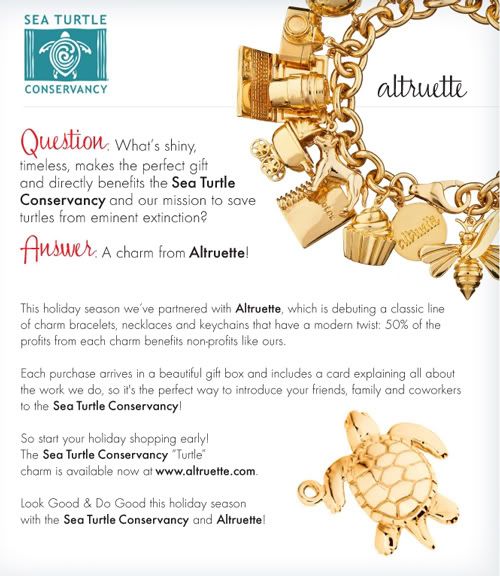
Since the oil spill, STC has doubled its efforts to reduce threats to sea turtles in Florida.
STC is traveling the state in search of problematic beachfront lights and working with residents, business owners and local sea turtle groups to install sea turtle-friendly lighting.
Supported by the National Fish and Wildlife Foundation, the program is reducing the negative impacts of lighting on sea turtles and hatchlings during nesting season.
Check out a before-and-after shot of this condo from the beach.
Before Window Tinting
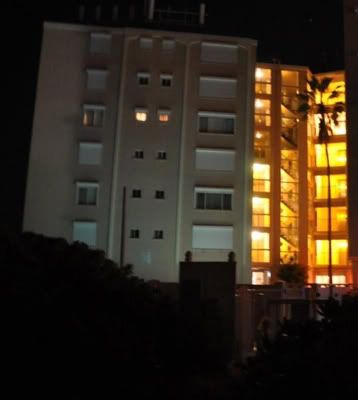
After Window Tinting
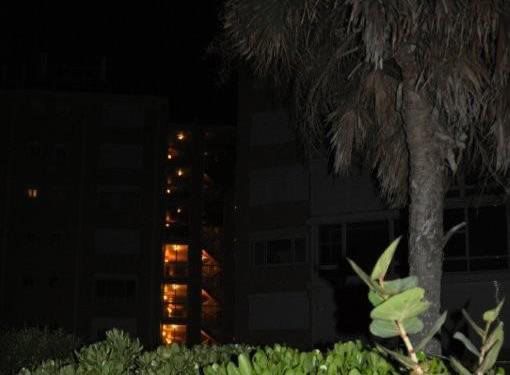
I recently was invited to join a team of veterinarians and biologists working for NOAA and the BP oil spill Unified Command on a trip into the Gulf of Mexico to document and rescue sea turtles impacted by oil. The trip also gave me an opportunity to observe first-hand the current status of ocean-surface conditions and the availability of suitable sea turtle habitat in that region of the Gulf.
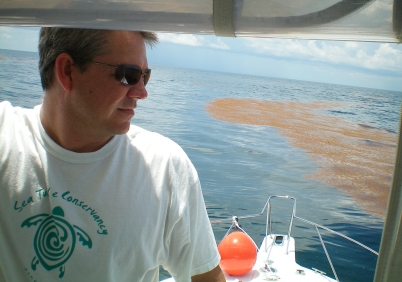 The 12-hour voyage departed from Venice, Louisiana, a small fishing community located at the southernmost point of land where the Mississippi River spills into the Gulf. Joining me on the trip were Dr. Brian Stacy, a NOAA veterinarian based at the University of Florida who has been coordinating sea turtle rescue efforts in the waters south of New Orleans and Dr. Joe Flanagan (a vet from the Houston Zoo). Also participating was Jonathan Gorham of In-water Research Group and representatives from two other conservation organizations (Chris Pincetich of the Sea Turtle Restoration Project and John Hammond with the National Wildlife Federation). Our primary task was to locate and rescue any sea turtles that might have been impacted by the oil spill.
The 12-hour voyage departed from Venice, Louisiana, a small fishing community located at the southernmost point of land where the Mississippi River spills into the Gulf. Joining me on the trip were Dr. Brian Stacy, a NOAA veterinarian based at the University of Florida who has been coordinating sea turtle rescue efforts in the waters south of New Orleans and Dr. Joe Flanagan (a vet from the Houston Zoo). Also participating was Jonathan Gorham of In-water Research Group and representatives from two other conservation organizations (Chris Pincetich of the Sea Turtle Restoration Project and John Hammond with the National Wildlife Federation). Our primary task was to locate and rescue any sea turtles that might have been impacted by the oil spill.
Rescue efforts such as this have been underway since shortly after the spill began, and they continue out of several port cities around the Gulf. Since the start of the disaster at the end of April, nearly 1,000 sea turtles have either stranded on Gulf Coast shores or have been recovered at sea through rescue efforts such as this.
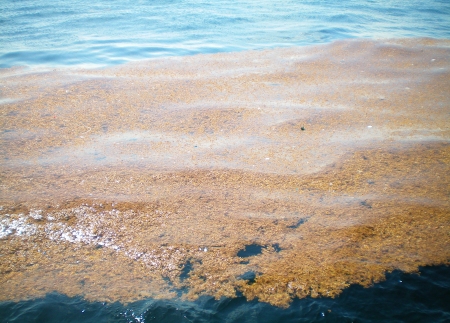 Our trip took us about 50 miles into the Gulf, where we began to spot mats of floating sargassum weed-an important pelagic habitat for both juvenile and hatchling sea turtles. Aside from tiny pieces of plastic and other types of common marine debris mixed in with the sargassum, the habitat we encountered appeared quite healthy. In fact, the mats were teaming with fish and other important marine species such as small shrimp, crabs and other vertebrates and invertebrates that sea turtles feed upon. Over the course of the day we also spotted and recovered two juvenile Kemp’s ridleys that showed no sign of having come in contact with oil.
Our trip took us about 50 miles into the Gulf, where we began to spot mats of floating sargassum weed-an important pelagic habitat for both juvenile and hatchling sea turtles. Aside from tiny pieces of plastic and other types of common marine debris mixed in with the sargassum, the habitat we encountered appeared quite healthy. In fact, the mats were teaming with fish and other important marine species such as small shrimp, crabs and other vertebrates and invertebrates that sea turtles feed upon. Over the course of the day we also spotted and recovered two juvenile Kemp’s ridleys that showed no sign of having come in contact with oil.
Considering that this very region of the Gulf was once thickly coated with oil, it seems most likely to me that the sargassum we encountered had drifted into the area, likely from the west, where it never came in contact with oil. Since the beginning of the spill, large amounts of oil-soaked sargassum have been corralled and burned by BP and its contractors. An undetermined amount of oil-soaked sargassum also has died and sunk below the surface by now. In this way, a substantial amount of important turtle habitat has been eliminated from the Gulf. However, this trip gave me great hope that sea turtles and their sargassum habitat are moving back into the region, but full recovery will take significantly longer.
My most striking memory from the trip is the complete absence of oil on the surface, despite our close proximity to the Deepwater Horizon oil spill site. On one hand I found it encouraging that the habitat, at least on the surface, appeared healthy. Unfortunately, conditions on the surface don’t tell the entire story about how oil and chemicals used to disburse the spill continue to impact the wildlife and ecology of the Gulf of Mexico. For government and non-government biologists alike, this remains a major concern, and research on what is happening below the surface needs to continue.
Based on my observations on this day and in this location, the surface habitat for sea turtles appears to be recovering a lot faster than most people, including me, thought would be possible. NOAA and other personnel responding to oil-impacted sea turtles are suggesting that their efforts to recover turtles at sea will soon wind down. While in hindsight it would have been better if more boats and rescue personnel had been in place to rescue turtles at the height of the spill, I can’t find fault with agency plans to scale back now. In fact, at this point chasing little Kemp’s ridleys out of healthy habitat seems more intrusive than helpful. Other threats to sea turtles, and especially the risk posed by the reopening of shrimp trawling in Louisiana waters, where state law does not require shrimpers to use Turtle Excluder Devices, presents a more significant survival threat to both loggerheads and Kemp’s ridleys. As efforts to rescue oil-impacted sea turtles wind down, state and federal regulators need to focus on bringing Louisiana commercial fishing regulations into the 21st century, where the harvesting of shrimp is done in ways that safeguard sea turtles and other common bycatch.
David Godfrey
STC Executive Director
The recent Deepwater Horizon disaster has focused attention on the value and importance of beaches to local economies, the quality of life, and as wildlife habitat. It has also ignited a discussion on whether to permanently ban oil drilling in Florida waters. Florida statutory laws prohibit nearshore drilling (within 10 miles on the Gulf coast and within 3 miles on the Atlantic coast), but state laws can easily be changed. Indeed, the Florida legislature had been working diligently to do away with this statutory ban and only recently abandoned this effort as the Deepwater Horizon continued to gush crude. Consequently, many policy makers and Floridians have been pushing for a more permanent “constitutional ban” that could only be changed by the voters and could not be overturned by the pro-drilling Florida legislature. Sea Turtle Conservancy (STC) has steadfastly opposed the legislature’s efforts to allow drilling while also advocating for a more permanent constitutional ban.
In early July, Governor Charlie Crist called for a legislative special session for the purpose of placing a constitutional amendment to ban drilling onto the November ballot. In an effort to gauge public support and hopefully convince legislators to support the governor, STC and four other Florida conservation groups conducted a survey of likely Florida voters. The survey results, released on July 19, just before the Governor’s special session, found that a majority of Floridians now oppose drilling in Florida’s near shore waters and a whopping 71% of Florida voters would like the opportunity to vote on a constitutional ban. A press conference was held in Tallahassee announcing the poll’s results.
The Special Session was called to order on July 20th. It lasted just 29 minutes, with the legislature ignoring the Governor’s efforts by adjourning without any hearings or votes on placing a constitutional ban on the ballot. Several conservation groups are now initiating a statewide citizen petition drive to place the constitutional amendment on the ballot. The STC will be strongly supporting this effort.
In other beach related news, the U.S. Supreme Court issued a ruling on June 17 upholding Florida’s beach restoration program. This very complicated case was initiated in 2004 when some beachfront property owners in the Florida Panhandle sued to stop the state from rebuilding their eroded beaches. When a “critically eroded” Florida beach is rebuilt, the new sand is considered to be public property. Since this new sand is placed between the old high tide line and the water, the beach front property owner’s property no longer touches the water and the new public sand effectively moves the high tide line further seaward. In a very simplified summation: property owners sued claiming the renourishment project resulted in a taking without compensation of their “riparian” rights to have their land touch the water. The case was appealed to the Florida Supreme Court in 2007 and eventually went to the U.S. Supreme Court. The Court ruled that the state’s beach nourishment program did not constitute a taking of private property without just compensation in violation of the U.S. Constitution. Had the property owners prevailed, Floridians would have had to pay first for the sand and then also for the right to place sand on a beach to protect the upland development. This could have effectively killed the state’s beach restoration program.
STC is involved in a myriad of issues addressing the long-term protection of Florida’s beaches. Beach management and protection is very complicated and attempts to balance environmental needs, public recreation, tourism, and protection of upland property. It is our mission to ensure the long term protection and health of Florida’s sea turtle nesting beaches and associated nearshore marine habitats.
Sea turtle nesting season is our favorite time at CCC, and this year we have been busy attending festivals throughout Florida to spread the word about sea turtle conservation. In addition to community outreach, CCC recently invited board members and volunteers on a trip to the Indian River Lagoon in Melbourne Beach, Florida, to observe in-water sea turtle research first hand. Thanks to our wonderful research partners at University of Central Florida, Dr. Llew Ehrhart and Dean Bagley, we were able to get up close with juvenile green and sub-adult loggerhead turtles. Check out the pictures of the lagoon trip and other community outreach events!
Dr. Ehrhart presenting to staff and volunteers
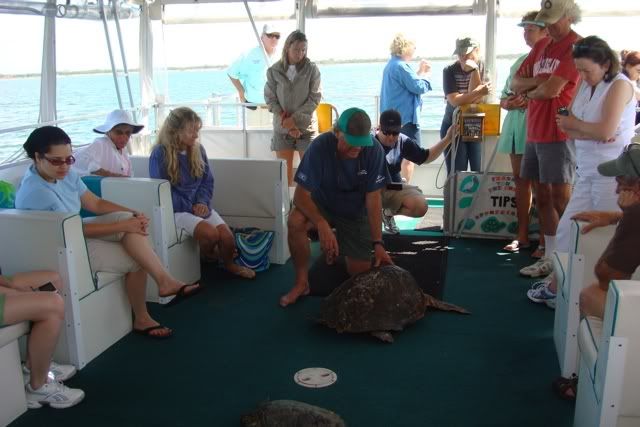
Juvenile Green Turtle
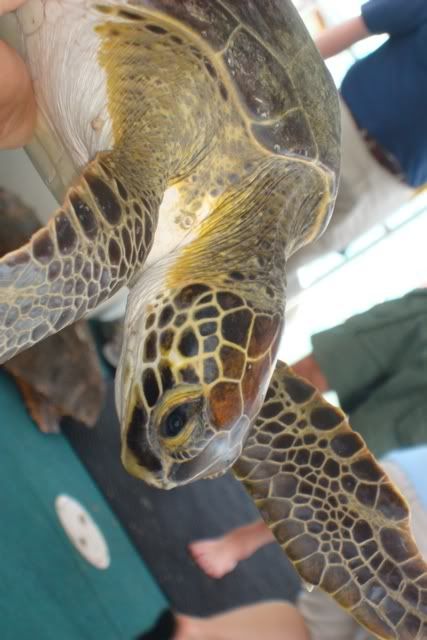
Board President Laura Forte holding a small green turtle

Dean Bagley and the UCF Marine Turtle Research Team
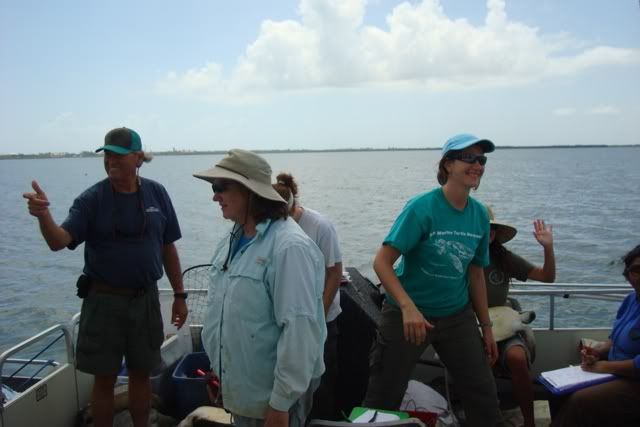
Baby Sam looking at the large green turtle
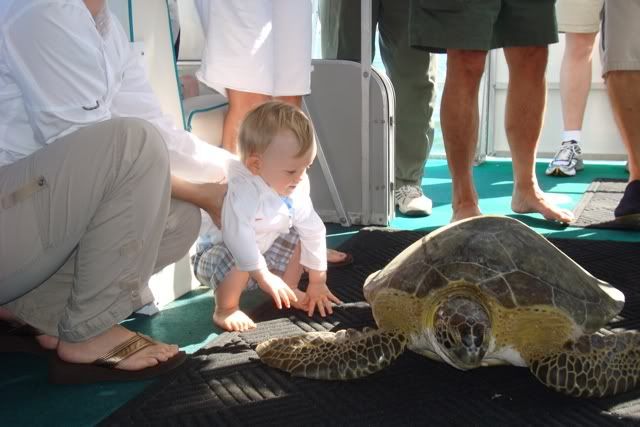
Volunteers pose with Communications Coordinator Rocio Johnson
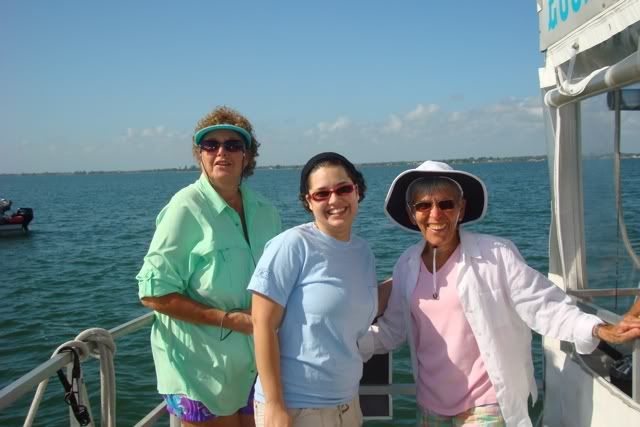
CCC exhibit at MarineQuest in St. Petersburge
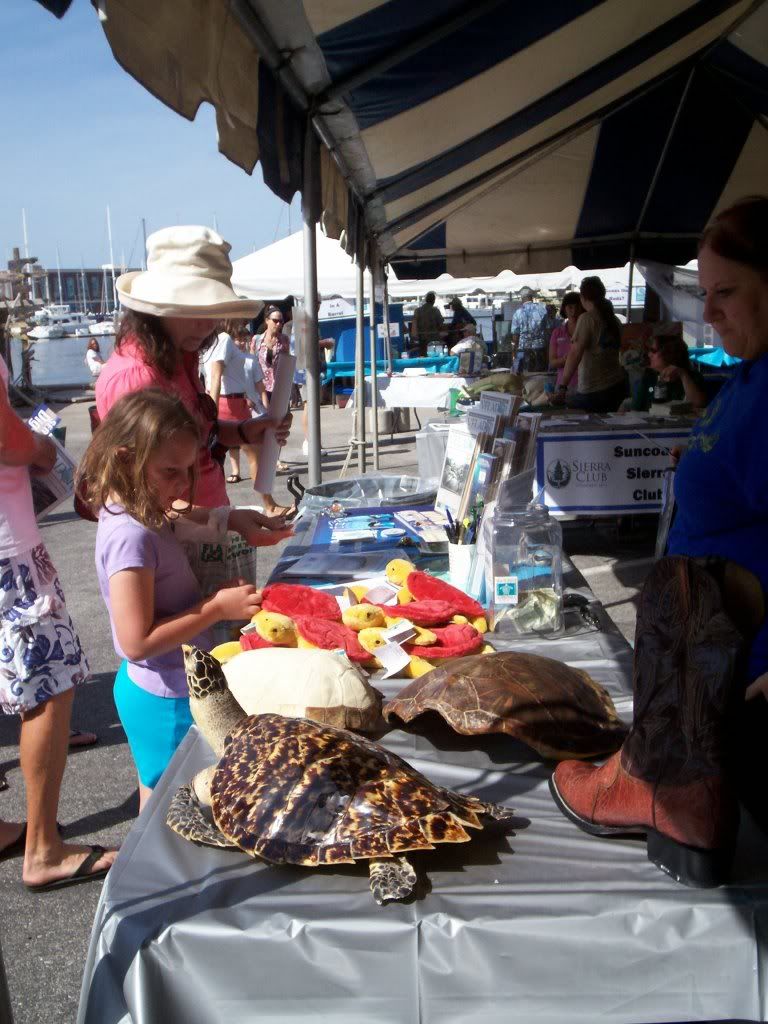
Kids working on the Causes Quilt for Tour de Turtles
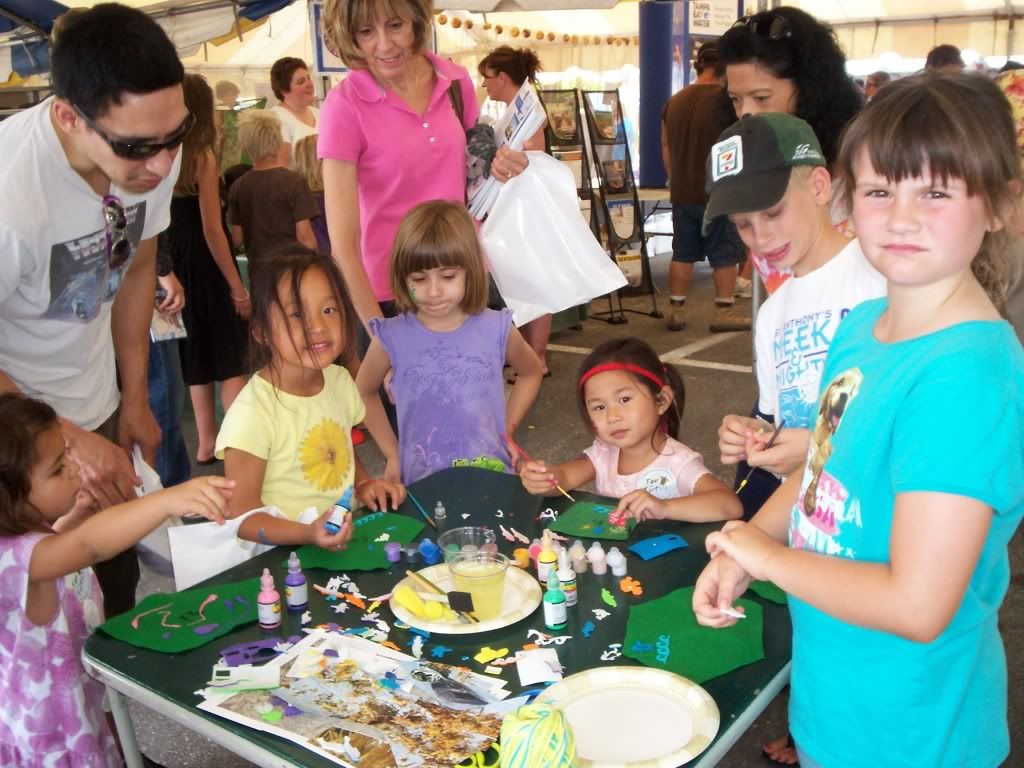
Parents and child learning about sea turtle threats
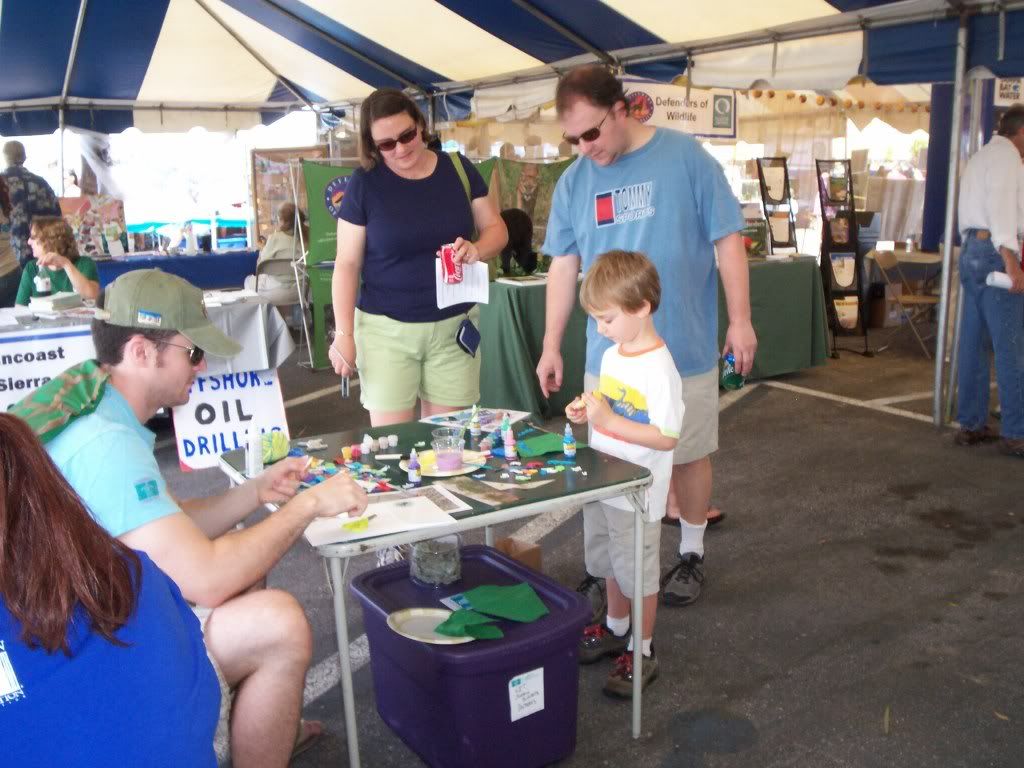
Quilt highlights sea turtle threats
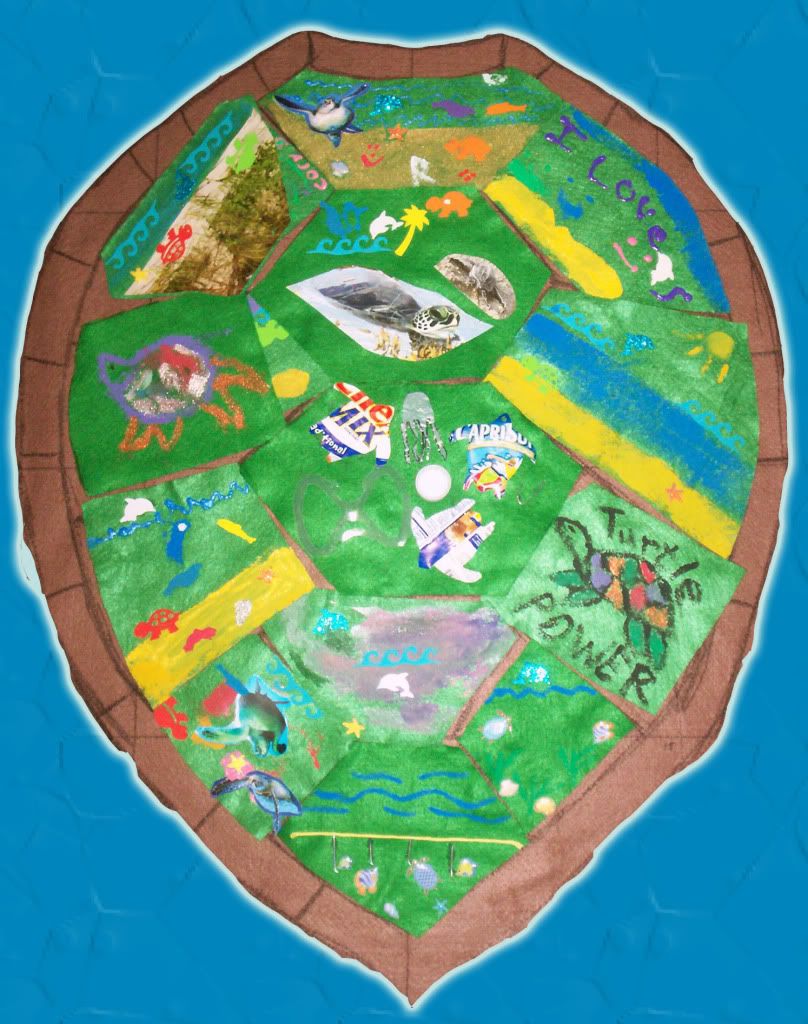
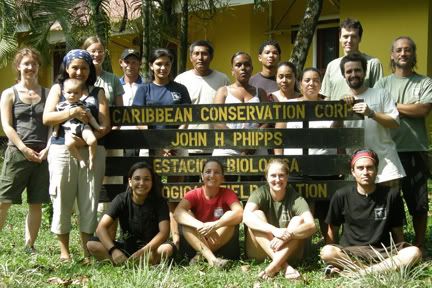
At the beginning of March, CCC staff and the new research assistants gathered at the Tortuguero Research Station for the start of a new leatherback nesting season.
We welcome the new CCC family members and are happy to see familiar faces back at the station this year. The members of the Tortuguero family are: Xavier Debade (Station Manager – France), Clare Atkinson (Field Coordinator – England), Dagnia Nolasco (Education and Outreach Coordinator – Peru), Perla Servian (Visitor Center Coordinator – Paraguay), Ivan Ramos (Track Surveyor, Boat Captain and Maintenance – Costa Rica), Juanita Fernández (Cook – Nicaragua), and Isabel Beckford & Jackeline Brandt (Cleaning and Laundry – Costa Rica).
This year we have eight Research Assistants from eight different countries; these unconditional turtle lovers are leaving behind their home comforts to give us their time and energy for three months: Alex (Canada), Arturo (USA), Ernesto (Mexico), Luisa (Venezuela), Marlene (Germany), Mónica (Colombia), Santiago (Spain), and Tim (England). We also have a Volunteer Assistant, Indira Torrez, who is from the community of Tortuguero; she participated in our Junior Research Assistant Program in 2008 and is now helping out with monitoring and environmental education activities. And we can’t forget our youngest turtler, 6-month-old Yana (French/Peruvian)!
After two weeks of intensive training, the Research Assistants and the field coordinator have been conducting nightly patrols and track surveys of the entire beach every three days.
Here are the turtle encounters during 203 hours of night patrols in March:
15 leatherback turtles – 6 new and 9 with old tags
7 green turtles – 6 new and 1 with old tags
Jaguar kills:
Two leatherbacks in two weeks – one originally tagged in Pacuare in 2005
6 green turtles – one tagged in Tortuguero in 2006
One of our research assistants (Ernesto) was lucky enough to see a jaguar while he was doing a track survey one morning; it was in the vegetation close to a freshly killed green turtle.
Our first Eco-volunteers have arrived, and are settling into the routine of early morning track surveys and late night patrols; and the turtles are starting to nest more frequently now too. We’ll keep you updated on how things progress during the season, and will be sure to share any exciting tales from the beach.
Dagnia and Clare
CCC Research Station